Many investors wish they had a crystal ball to help them predict what will happen with the economy and their investments. What they don’t understand is that something just like a crystal ball does exist – it’s called the Treasury Yield Curve.
Arturo Estrella and Mary R. Trubin, in a paper published by the New York Federal Reserve Bank entitled: The Yield Curve as a Leading Indicator: Some Practical Issues, state:
“Before each of the last six recessions, short-term interest rates rose above long-term rates, reversing the customary pattern and producing what economists call a yield curve inversion. Thus, it is not surprising that the recent flattening of the yield curve has attracted the attention of the media and financial markets and prompted speculation about the possibility of a new downturn. Since the 1980s, an extensive literature has developed in support of the yield curve as a reliable predictor of recessions and future economic activity more generally. Indeed, studies have linked the slope of the yield curve to subsequent changes in GDP, consumption, industrial production, and investment.”
This paper was published in late 2006. The “possibility of a new downturn” did indeed occur as we now know – the largest downturn since the Great Depression.
The charts included in the paper by Estrella and Trubin graphically illustrate the correlation between an inverted yield curve and a future recession.
What is the Treasury Yield Curve?
The Treasury Yield Curve plots the various yields of government Treasury bills, notes, and bonds based on yield and maturity at a certain time. It starts with short term 1-month bills and ends with long-term 30 year bonds. Below is a graph of the yield curve for April 1, 2011. Maturity goes on the x-axis and yield in the y-axis.
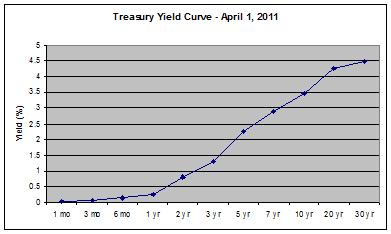
While no one knows for sure why the yield curve is such an accurate predictor, here are several theories:
- Investor behavior is very different depending on the term of the maturity and much of this behavior is dependent on investor expectations of economic growth. Thus, the Treasury market reflects investor’s future expectations of growth and economic performance.
- When buying treasuries, investors make bets on where they think the economy is going and back it up with their money. Talk is cheap, but actually putting money down on something marks a real belief.
- With so many billions being bought and sold of Treasuries, the market is one of the most efficient and represents the beliefs of investors from across the globe.
So, let’s take a look at how to read a Treasury Yield Curve. First, let’s look at the curve from April 1, 2011. As you can see, the curve moves upward. Indeed the spread between the shorter maturity (3 month t-bill) and a long term bond (30 year Treasury) is 4.45%, historically very high. This is a steep yield curve.
Steep Yield Curve
A steep yield curve is almost always a sign of an economic recovery. A yield curve is thought to be steep during the early stages of an economic recovery because long term investors, smelling the recovery, start to demand higher rates so they are not locked in at a lower level. Short term investors do not demand an adjustment as quickly because they are not locked in for long periods of time. They have the flexibility to buy high yield securities in a matter of months. In addition, short-term rates are very much influenced by the Federal Reserve, which often keeps rates low at the early stages of an economy to ensure the recovery is sustained.
So the fact the yield curve is so steep now is a good omen. Looking into the crystal ball, it is saying that economic recovery is coming.
Inverted Yield Curve
The opposite of a steep yield curve is an inverted curve. The natural shape of the curve is a gradual slope upward. That’s because investors usually demand more money the longer the term of the investment. Think about CD rates. You’d want to earn more money with a 5 year CD than a 1 year. Why? Because you want to be compensated for locking up your money for a longer period of time. The same thing is true with Treasuries.
When the curve gets inverted, short term rates are higher than long-term rates. Why is this? It’s not entirely clear but one theory postulates that investors will often settle for lower longer-term rates now if they believe that rates will be even lower in the future. Think back again to what happened in 2008 when 5-year CD rates were 5%. At that time, an investor would have been smart to lock-in even at 4.5%, considering that rates have plummeted down to below 3%. The same behavior probably impacts the Treasury market. Put another way, investors expect that high short-term rates will eventually lead to a cooling economy and monetary easing and long-term rates flatten, reflecting this crystal ball sentiment.
Look at the yield curve in September 2007. This was before Bear Stearns failed and the economy was still going strong. Even though oil prices were high, the Fed still believed we’d avoid an economic meltdown, Lehman Brothers was still around, and GM was two years away from going through bankruptcy. But anyone looking at the Yield Curve crystal ball could see that trouble was coming.
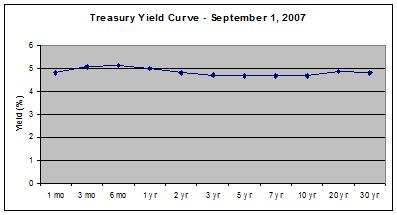
Normal Curve
A normal curve looks slightly like a Steep Curve but the difference between short-term and long-term rates is around 3%. In a normal curve environment, the economy is humming along and everyone is happy. Normal curves eventually devolve into Inverted Curves, it’s just a question of when.
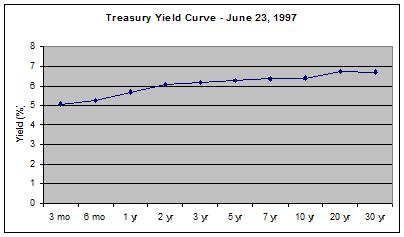
Historical Accuracy
In general, the yield curve has predicted every US recession going back to the 1970s. It is the single best indicator of an oncoming economic slowdown. If there is just one economic indicator you watch then the Yield Curve should be it. The US Treasury has a good tool for tracking yield curve changes and also for exploring historical data.


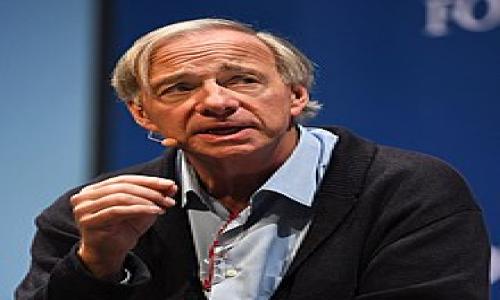
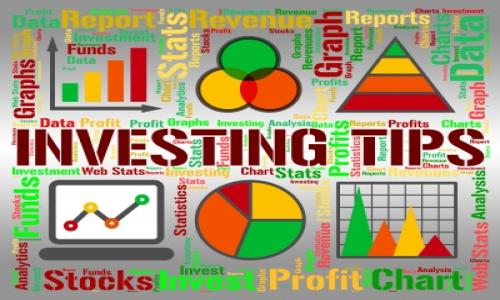
Add your Comment
or use your BestCashCow account